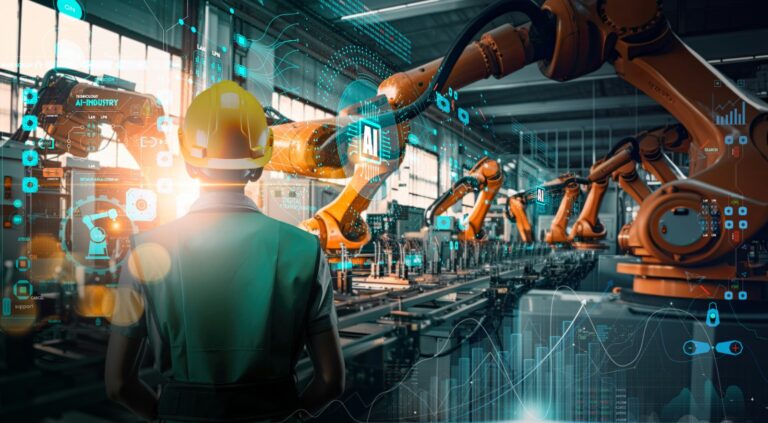Since the industrial revolution, factories have always been associated with light, human labor, and shift based production. Today, however, the world of manufacturing is on the brink of a very different transformation: dark factories. These facilities operate without lights, without shifts, powered by machines and artificial intelligence that run production seamlessly, 24/7. They are already showcasing what the future standards of industry will look like.
In this blog post, I explored examples of dark factories across the world—from Philips Drachten in the Netherlands to Siemens Amberg in Germany, and from Xiaomi to Gree in China. Despite being in different parts of the world, they all converge on a single point: the factories of the future shine in the dark.
What is a Dark Factory?
A dark factory is a facility where no human labor is involved in the production process—it is entirely managed through automation, robotic systems, and artificial intelligence.
- Production lines are operated by robots.
- Material flow is handled by AGVs (Automated Guided Vehicles) or AMRs (Autonomous Mobile Robots).
- Quality control is performed automatically using vision-based inspection systems.
- The entire operation of the facility is managed through a centralized AI/MES (Manufacturing Execution System).
Because of this, there is no need for lighting, heating/cooling, or traditional ergonomic arrangements. In other words, even if the “lights are off,” production continues seamlessly.
Dark Factory: Historical Development
| Year / Period | Development | Description |
| 1970s | First ideas | With the rise of automation in Japan and the U.S., the concept of the “unmanned factory” began to appear in the literature. |
| 1980s – 1990s | Pilot applications in electronics & automotive | Automotive giants and electronics manufacturers increased the density of robots on assembly lines, experiencing the first dark factory practices. However, due to technological limitations, full automation was not yet possible. Fanuc led the way in these early implementations. |
| 2000s | Digitalization & robotics development | Advances in sensors, industrial robots, and production software made the dark factory concept shift from theory to a more practical reality. |
| 2011 | Industry 4.0 launch (Germany, Hannover Fair) | With the vision introduced by Kagermann, Wahlster, and Lukas, the concept of the smart factory came into the spotlight. The dark factory was redefined as an extreme example of this vision. |
| 2015 – 2020 | Pilot projects | “Lights-out” factories were implemented in automotive, electronics, and semiconductor sectors across China, Germany, the U.S., and the Netherlands (e.g., Philips Drachten, Siemens Amberg). |
| Post-2020 | Fully automated facility examples | – Xiaomi Smart Factory (China, 2021): A $330M investment aiming to achieve unmanned smartphone production. – Gree Gaolan Factory (China, 2023): A 5.5G-enabled, lights-out facility with a capacity of 12 million air conditioners per year. |
| Today (2025) | Hybrid & fully automated factories | Fully unmanned dark factories are still rare, but hybrid models (human + robot collaboration) are becoming widespread. Industry 4.0 infrastructure (IoT, AI, digital twins, vision systems) is turning this vision into reality. |

“What we all have to do is make sure we are using artificial intelligence in a way that is for the benefit of humanity; not in a way that is harmful to humanity.”
Tim Cook
Examples of Lights-out Manufacturing / Dark Factories
Xiomi
Xiaomi’s Changping Smart Factory: A 24/7 Dark Factory
In 2023, Xiaomi made global headlines with the opening of its smart manufacturing facility in Beijing’s Changping district. Covering an area of around 81,000 square meters—equivalent to 11 football fields—this factory stands out as a fully automated “lights-out” manufacturing site.
No Lights – No Breaks – No Shifts
As Xiaomi describes it, not a single human is present on the shop floor. Production runs continuously, 24/7. There are no shift changes, no meal breaks, no rest periods—robots and AI systems keep operations flowing without interruption.
Capacity and Production Goals
-
Production capacity: Over 1 million smartphones per year
-
Line design: Fully automated assembly line
-
Product focus: Primarily smartphones, serving as a pilot line for Xiaomi’s next-generation devices
Technology: Hyper Intelligent Manufacturing Platform (HyperIMP)
At the heart of the factory lies Xiaomi’s self-developed Hyper Intelligent Manufacturing Platform (HyperIMP). Thanks to this system:
-
Production processes are optimized in real time with artificial intelligence.
-
Quality control is performed automatically on the line through image processing.
-
Predictive maintenance algorithms identify potential failures in advance.
-
Data-driven decision-making continuously improves production planning and resource utilization.
Xiaomi’s Dark Factory Experience
-
Work environment: The term “dark factory” refers to a facility where the lights are off and no human presence is required. In practice, people still intervene in areas such as maintenance, software control, or supply processes—but the assembly line phase itself is operated 100% automatically.
-
Efficiency: Reduced human error, increased speed, and 24-hour production provide significant cost advantages.
-
Flexibility: The system can be reprogrammed via software to produce different models on the same line.
Xiaomi’s Vision
With this factory, Xiaomi aims not only to expand its own production capacity but also to contribute to China’s broader vision of smart manufacturing. The Changping facility is regarded as one of the most striking examples of the “dark factory” trend in China.
Xiaomi’s Changping factory serves as a showcase of the production model of the future. While a model of manufacturing completely free of human labor has not yet spread across all processes, this facility is a powerful demonstration of how far automation has advanced. A world of production with no lights, no shifts, and no breaks is no longer science fiction—Xiaomi has already put it into practice.
Gree
Gree’s 5.5G-Based Dark Factory: The World’s Largest Example
One of the most striking examples of the dark factory concept is Gree Electric Appliances’ Gaolan Smart Manufacturing Facility in Zhuhai, China.
The World’s Largest 5.5G Native Lights-out Factory
Developed in collaboration with Gree and China Unicom, this facility has earned the title of “the world’s largest 5.5G-based dark factory.” The plant is built entirely on a 5.5G native private network, enabling ultra-low latency, high bandwidth, and real-time data transmission across all production processes.
Capacity and Efficiency
- Annual production capacity: ~12 million split air conditioners
- Efficiency: Approximately 86% higher than traditional factories
- Workforce profile: No human labor is involved in the main production processes; only a small number of staff are assigned for maintenance, quality control, and supervision.
Technology and Innovations
- Digital twin: An 80,000 m² warehouse has been designed with a digital twin and is managed by AGVs/AMRs.
- 5.5G integration: RedCap terminals and IoT devices enable production, quality control, and logistics processes to operate in an integrated manner over a single network.
- Real-time quality control: Smart sensors and high bandwidth ensure error-free and fully traceable production.
Global Recognition
- The factory won the Best Private Network Solution award at the GSMA GLOMO Awards 2025.
- It was officially recognized as a “National Smart Manufacturing Demonstration Factory” by China’s Ministry of Industry and Information Technology.
Gree’s Vision
Gree’s Gaolan factory not only demonstrates the current state of automation but also highlights the transformative impact of 5.5G in industry. While fully unmanned production remains an ideal target, this facility—operating with limited human involvement in areas such as maintenance and quality—has become the largest example of the “dark factory” concept in the world.
Philips
Philips Drachten Factory, Netherlands
In Drachten, the Netherlands, Philips operates a partially lights-out factory where electric shavers are produced. At this facility, 128 robots carry out most of the assembly tasks, while only nine employees manage quality assurance processes.
The production system is highly modular: flexible robotic cells and vision systems allow the plant to quickly switch between different shaver models. This flexibility helps the factory remain competitive in markets where consumer preferences shift rapidly.
Siemens
Siemens Amberg Factory, Germany
Siemens’ Amberg facility is one of the leading examples of AI-driven manufacturing. More than 75% of the production process is automated, with minimal human intervention. The factory produces Programmable Logic Controllers (PLCs), a core component of automation worldwide.
Thanks to AI-powered production, the facility achieves an impressive product quality rate of 99.99885%. Artificial intelligence algorithms continuously monitor the assembly line, ensuring each unit is manufactured with the highest precision.
The “dark factory” concept at Amberg represents a blend of high efficiency, reduced downtime, and exceptional product quality.
Advantages of Dark Factories
-
Uninterrupted production: Operates 24/7 without the concept of shifts.
-
Cost savings: Reduces labor costs and improves energy efficiency.
-
Quality: Eliminates human error and ensures standardization.
-
Traceability: All data is digitally recorded, enabling easy retrospective analysis.
-
Flexibility: AI-powered systems can quickly adapt to new products.
Challenges of Dark Factories
-
High investment cost: Significant upfront investment is required for robots, sensors, software, and system integration.
-
Cybersecurity risks: Fully digital systems are vulnerable to potential cyberattacks.
-
Employment concerns: The role of human labor changes; a shift from blue-collar workers to data analysts and robot maintenance specialists is required.
-
Limits of flexibility: Certain specialized assembly tasks that require manual dexterity may still depend on human workers.
Where Does the Human Factor Go?
-
The dark factory does not eliminate humans entirely; rather, it shifts their roles from the production line to areas such as management, planning, and maintenance:
-
Robot technicians
-
Data analysts
-
Artificial intelligence operators
-
Digital twin engineers
This transformation means that employees are redirected toward more value-added tasks.
Conclusion: The Factories of the Future Shine in the Dark
The concept of the dark factory is not merely about turning off the lights. It represents a transformation where human intervention is minimized, smart systems and robots operate seamlessly, and efficiency, quality, and sustainability are redefined.
From Philips Drachten to Siemens Amberg, and from Xiaomi’s Changping smart facility to Gree’s massive 5.5G-based factory, this journey highlights a single truth: the future of industry lies at the intersection of automation, artificial intelligence, and digital network technologies.
Although humans are still needed for maintenance, quality control, and strategic decision-making, machines and algorithms are rapidly taking over the majority of production. This shift is not only about cost and speed but also about environmental sustainability, energy efficiency, and global competitiveness.
Dark factories, built on the bold steps of today, are becoming the standards of tomorrow. And perhaps very soon, production floors where “the lights never come on” will no longer feel extraordinary—but simply an ordinary part of both industry and our daily lives.
Frequently Asked Questions
1. What exactly is a “dark factory,” and what are its core technologies?
A dark factory is a facility managed entirely by automation, robotic systems, and artificial intelligence, where no humans work in the production process. In these facilities, there is no need for lighting, heating/cooling, or conventional ergonomic arrangements because production continues even if the “lights are off”. Its core technologies include production lines operated by robots , material flow handled by AGVs (Automated Guided Vehicles) or AMRs (Autonomous Mobile Robots) , automated quality control through image processing systems , and a central artificial intelligence / MES (Manufacturing Execution System) that manages the entire operation.
2. What are the most significant advantages of dark factories?
The main advantages of dark factories are:
- Uninterrupted Production: They operate 24/7 without the concept of shifts.
- Cost Savings: They significantly reduce labor costs and provide energy efficiency.
- High Quality: They eliminate human error and ensure standardization in production.
- Flexibility: AI-powered systems can quickly adapt to the production of new products.
- Traceability: Since all production data is digitally recorded, retrospective analysis becomes easy.
3. Are there any challenges or disadvantages to establishing a dark factory?
Yes, there are several significant challenges in establishing a dark factory. Chief among them is the high initial investment cost required for technologies like robots, sensors, and software. The fact that all systems are connected to digital networks creates a vulnerability to cybersecurity attacks. Furthermore, some specialized assembly tasks that require manual dexterity may still need human intervention, which constitutes a flexibility limit for full automation.
4. Is the human factor completely eliminated in these factories? What will be the new role for people?
No, dark factories do not completely exclude humans from the process; they only change their role. The human workforce shifts from the direct production line to more value-added areas such as management, planning, maintenance, and supervision. With this transformation, new specialized roles will be needed, including robot technicians , data analysts , artificial intelligence operators , and digital twin engineers.
5. What specific examples of dark factories are mentioned in the article?
The article provides several key examples of dark factories from around the world:
- Xiaomi (China): Its smart factory in Beijing operates with the goal of 24/7 unmanned production of smartphones.
- Gree (China): This facility in Zhuhai is known as the world’s largest 5.5G-based dark factory and has the capacity to produce 12 million air conditioners annually.
- Philips (Netherlands): At this facility in Drachten, 128 robots produce electric shavers, while only nine employees manage quality assurance processes.
- Siemens (Germany): At the Amberg factory, over 75% of the production process is automated , achieving a very high product quality rate of 99.99885%.

